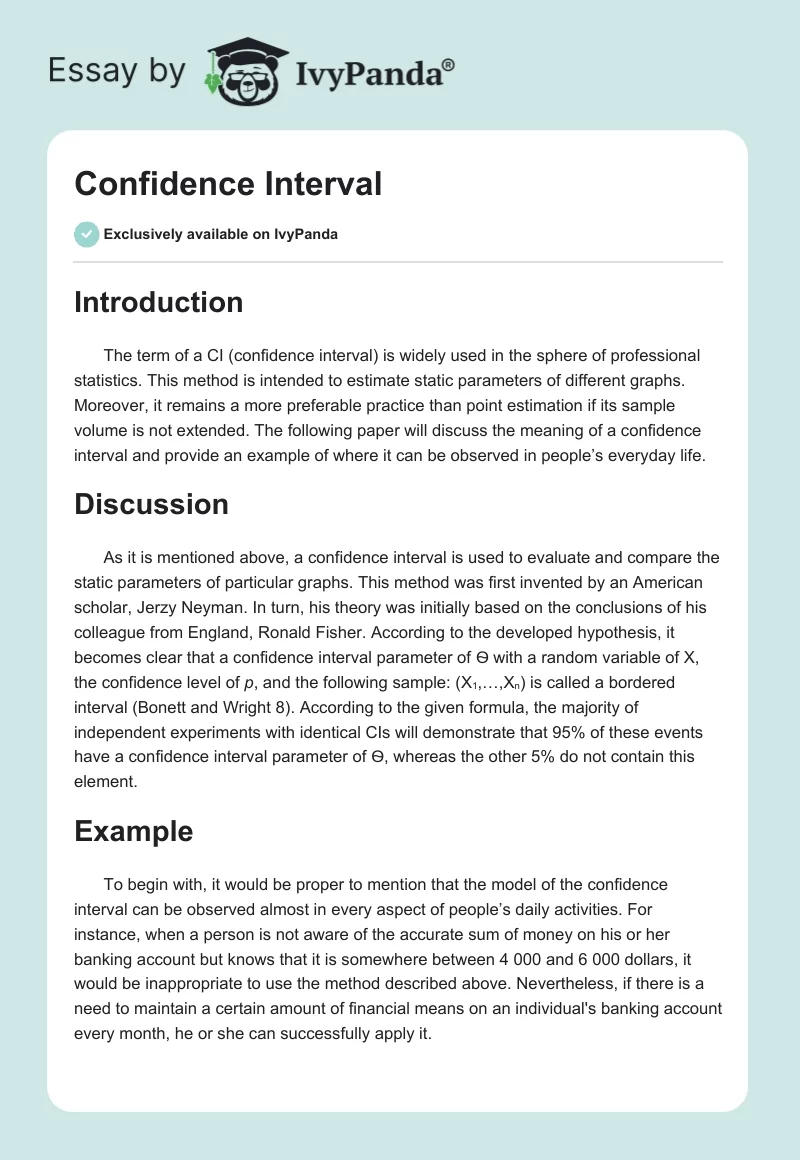Introduction
The term of a CI (confidence interval) is widely used in the sphere of professional statistics. This method is intended to estimate static parameters of different graphs. Moreover, it remains a more preferable practice than point estimation if its sample volume is not extended. The following paper will discuss the meaning of a confidence interval and provide an example of where it can be observed in people’s everyday life.
Discussion
As it is mentioned above, a confidence interval is used to evaluate and compare the static parameters of particular graphs. This method was first invented by an American scholar, Jerzy Neyman. In turn, his theory was initially based on the conclusions of his colleague from England, Ronald Fisher. According to the developed hypothesis, it becomes clear that a confidence interval parameter of Ѳ with a random variable of X, the confidence level of p, and the following sample: (X1,…,Xn) is called a bordered interval (Bonett and Wright 8). According to the given formula, the majority of independent experiments with identical CIs will demonstrate that 95% of these events have a confidence interval parameter of Ѳ, whereas the other 5% do not contain this element.
Example
To begin with, it would be proper to mention that the model of the confidence interval can be observed almost in every aspect of people’s daily activities. For instance, when a person is not aware of the accurate sum of money on his or her banking account but knows that it is somewhere between 4 000 and 6 000 dollars, it would be inappropriate to use the method described above. Nevertheless, if there is a need to maintain a certain amount of financial means on an individual’s banking account every month, he or she can successfully apply it.
Hence, one might count the sum left on the card at the end of every day to acquire precise statistics of regular expenses. Then, it is essential to calculate all the available money at the end of a certain period (not longer than six months). This lets the account owner find the standard deviation and mean.
The acquired result gives the person an understanding of the average sum he or she is likely to carry from this point. In turn, all other objects will remain equal. The analysis of all the collected statistics for every month in the past will predict its consistent tendency in the future. It is necessary to mention that the given model can be implemented in a wide range of details or daily activities. For example, it is possible to analyze tire pressure with the method of the confidence interval, money spent on entertainment, the time required to get from one place to another, proportions of ingredients used to cook a certain meal, prices of different goods, utility bills, and many other factors.
Pros and Cons
The advantages of using the confidence interval measurement in the case of the sum on the banking account described above imply the fact that this method is much easier to use than doing the same calculation with the help of significance tests (Knapp 263). Moreover, confidence intervals accurately determine the exact estimate of a certain parameter. However, the discussed model is not recommended to be used for identifying or analyzing insignificant numbers or indicators due to its complexity.
Conclusion
The method of confidence interval estimation can be used in various aspects of individuals’ daily lives. This model is unique because it precisely identifies the required data or its statistics. However, the majority of people do not use it on a regular basis because it presents certain complexities.
Works Cited
Bonett, Douglas, and Thomas Wright. “Cronbach’s Alpha Reliability: Interval Estimation, Hypothesis Testing, and Sample Size Planning.” Journal of Organizational Behavior, vol. 36, no. 1, 2014, pp. 3–15.
Knapp, Thomas. “Significance Test, Confidence Interval, Both or Neither?” Clinical Nursing Research, vol. 26, no. 3, 2017, pp. 259–265.


